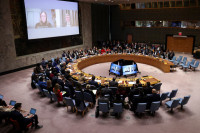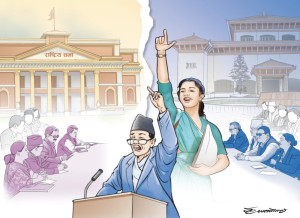Columns
Climate change adds to children’s woes
Climate-induced disasters hinder their access to health, education, nutrition and protection.
Richa Gurung
Children and young people face the biggest brunt of climate change, including disasters. Studies suggest that it will worsen in the near future. For children in Nepal, climate change is a catastrophe for their right to survive and grow. According to a study titled “Impacts of Climate Crisis and Environmental Degradation on Children and Youth in Nepal”, published by the Child-centred Disaster Risk Reduction and Climate Change (CDCC) Consortium in 2021, half of the people killed or injured by climate hazards from 2015 to 2020 were children and youths.
Climate-induced disasters hinder children’s access to health, education, nutrition and protection. Even though children are not accountable for environmental crisis and climate change, they are often the most affected by its consequences, which include increased risk of violence and abuse through displacement, loss of homes, disruption of lives, inequality and child labour.
Overlooking the vulnerable
Children in Nepal are vulnerable to the adverse effects of climate change due to their cognitive and psychological condition, developing brains, exposure to illness and limited capacity to adapt to threats and impacts. They are more likely to experience trauma, fear and anxiety. Moreover, climate hazards cause biodiversity loss and a decline in agricultural productivity, leading to inadequate food supply and widespread hunger among children.
The rain-induced disasters reported throughout the country and the pre-monsoon heat waves in the western region show the country is facing unpredictable climate patterns and climate disasters, making life difficult for many, where child malnutrition and infant mortality are already very high. More frequent droughts and floods challenge the existing rain-fed agriculture practices, exacerbating the food crisis in Nepal’s rural areas. A survey conducted in 2019 found that Muktikot in Swami Kartik Khapar Municipality in Bajura had the highest number of malnourished children.
Moreover, due to climate change, children and adolescents are deprived of education. Climate disasters often lead to the inability of parents to pay for their children’s academic fees. When parents are forced to make decisions, stereotypically, young girls suffer greatly and are excluded from school. They are often deprived of their essential needs and recreational activities and are most likely to be married off due to the financial constraints of their families. As a result, up to 40 percent of girls marry before the age of 18 and 14 percent of them give birth to their first child before turning 19, despite the government’s consistent efforts to end child marriage.
Call for action
The government needs to recognise the importance of supporting children through education and integrating climate education into the curriculum. This will help the children to navigate the issues like climate change. Even though the Curriculum Development Centre, in December 2019, announced that it would include climate education for the first time in Nepal’s education goals in the national curriculum, many education experts and schoolteachers across Nepal stated that access to educational resources on climate change remains restrained. Dedicated lessons about climate change are given only until Grades 7 and 8. After that, the state curriculum does not specify particular books for higher schooling to learn more about the climate crisis and other environmental issues.
Likewise, teachers in rural Nepal do not have sufficient resources or training to make teaching effective and have to rely on other learning platforms like YouTube and educational books to educate children on climate change. According to a study by Unicef in 2020, out of almost 26,000 respondents between the age of 15 and 24 across eight South Asian countries, only 34 percent out of 4,197 students in Nepal testified that they could explain climate change and global warming adequately. This is why the government should prioritise children’s learning towards climate change, its impacts and adaptation measures, as every child must be equipped with an understanding of environmental crisis from a young age.
The rights of children are intertwined with climate change and environmental dangers. Though there is a mention of children in disaster-related plans in Nationally Determined Contributions (NDC) and National Adaptation Plan (NAP), there is a significant gap in implementing these policies. Similarly, it is crucial to gather evidence that shows the impacts of climate hazards on children. It is also necessary to increase the funding for research on the impact of climate change on children. Such efforts can prove beneficial for children in the face of climate adversity.




 16.16°C Kathmandu
16.16°C Kathmandu















